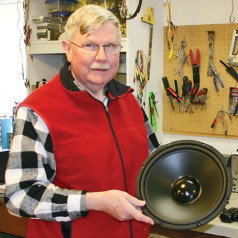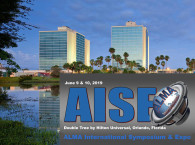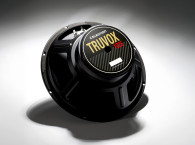
Mr. Weems begin his education in a one room school house in Newtonia, Missouri. He later attended Drury College in Springfield, MO where he studied chemistry, physics, math and German. Because of his German studies, and Pearl Harbor, soon led him slogging through Germany with Patton's Third Army as an interpreter. After the war he ended up in California where he continued his studies at UCLA. After earning his bachelor's degree he taught high school physics, chemistry and photography. He met his late wife in California, Charys; they had one child, Helen who teaches music in Maryland.
Weems interest in audio began when he tinkered with an old five tube radio with the usual 4 inch speaker. He built a larger baffle with a 6 inch speaker and, as he said in an October 2009 interview in AudioXpress, “The improvement in sound was dramatic: and I was hooked.” He then bought some 12 inch surplus speakers to experiment with and this led to his more than 50 years of articles starting with the first one in the September 1954 issue of Audio magazine. Most of Mr. Weems articles can be found on the Popular Electronics section of the www.worldradiohistory.com web site. While out of print, many of Weems’ books can still be found through Amazon and Ebay sites.
Mr. Weems continued doing speaker projects until his wife developed lymphoma in 2002 and passed away in 2006. Since that time he enjoyed spending time with his friends in Newtonia and working with the local historical society in history preservation. He continued his interest in audio through correspondence with past friends and was interested in what effect DSP was having on speaker and system design. He will be remembered by his friends and loved ones and by the many who have enjoyed the results of building his prolific speaker projects.
The interview I did with Dave Weems, published in audioXpress October 2009, is fully transcribed below.

For five decades, the name David B. Weems has been known to the DIY speaker builder. From his first article in Audio in 1954, to his last book in 2000, Dave Weems has made major contributions to the hobby, and inspired generations of speaker enthusiasts to try his designs or originate their own. I had the privilege of interviewing Mr. Weems in his home in Neosho, Mo., in March 2009, and what follows is a distillation of that interview.
Bird: You are originally from this area of Missouri. When were you born?
Weems: I was born in 1922, in the country near Granby, Missouri, and after a year my parents moved to Newtonia, Mo., which is just east of Neosho.
Bird: So you were raised in Newtonia.
Weems: Yes, my father was a farmer near there and I went to school at Newtonia.
Bird: That was until WWII?
Weems: No. I first attended Drury College in Springfield, Mo., where I studied chemistry, physics, math, and German, as I was interested in a degree in physical science.
Bird: Did you serve in WWII?
Weems: After Pearl Harbor a friend and I were selected to go to St. Louis to be tested for the NAVY V5 flyer program. They rejected me due to an old ankle injury (it had once been run over by a truck). However, when I was called up, the Army did not find it a hindrance for 25-mile hikes. I entered the US Army at Camp Crowder, near Newtonia in 1943, and served in Europe with Patton’s Third Army. They discovered I had studied German in college, so they made me an interpreter.
Bird: What did you do after the war?
Weems: After being discharged in February of 1946, I eventually ended up in southern California, and enrolled at UCLA, to complete my bachelor’s degree. I got a job working as a lab technician for the UCLA College of Agriculture, doing soil physics. I later worked temporarily for the Engineering College at UCLA on a defense contract and that job ended when the funding stopped. Other than that, most of my jobs were teaching—first general science and later physics and chemistry.
I also taught a photography class for a few years. Most of my writing has been freelance except for writing a manual for a water and wastewater school.
I met my wife, Charys, at UCLA. She was from Beverly Hills, and we were married shortly after I graduated.
Bird: Do you have any children?
Weems: I have a daughter Helen, who studied music at UCLA and worked for the musicologist Mendel Hood, who was also our best man. I think her interest in music was inspired by hearing a number of good speaker systems under development as she grew up. Helen now lives in Columbia, Md., where she teaches music.
Bird: How did you get interested in audio?
Weems: I had an old five-tube radio with a 4” PM speaker, and did not like the sound quality. I built a larger baffle and used a 6″” speaker. The improvement in sound was dramatic to me, and I was hooked.
One of my first projects involved some 12” speakers I found at a surplus dealer in Hollywood. They were very cheap at $2 apiece. I experimented with them, and found the low end was lacking. They had very stiff paper cones and high resonant frequency. I had just enough knowledge of physics, and from reading Audio, to know that a lower resonance would produce better bass.
I experimented with various modification methods and finally settled on replacing the surround with chamois material. I cut the original outer edge suspension away and glued the chamois in its place. It produced a very low resonant speaker and was the basis for my first article in the Sept. issue of Audio in 1954. An interesting aspect was that I used a clothes sprinkler head for the dust cap and it worked quite well. (KB: For the article, see Audio Anthology, Volume Three, p. 13, Audio Amateur Publications, 1990.)
It developed into somewhat of a business, as I had requests from local audiophiles for the modified speakers. I sold a number of them, and on some weekends my apartment was besieged with customers. In those days, there was not too much literature available on speaker building, and there was a lot of disagreement on tuning a speaker cabinet. My chamois-modified driver taught me a lot about housing speakers.
I remember one customer, a lady from Pasadena, who had bought one, and it was mounted in a sealed or infinite baffle. She called and complained that the speaker was now distorting at higher levels. I took the train up there, and while onboard I thought about her problem. She had a small 1 or 2W amplifier in her system at the time. A few months later she got a larger amp, I believe it was 25W, and I thought it may be overloading the speaker.
That’s when the thought of reducing the cabinet volume hit me. When I arrived, I fired up her new amplifier and, sure enough, the speaker was being driven beyond the magnetic field. After some thought, I decided to try and reduce the volume of the box. I asked her whether she had any loose bricks on the property.
She said no, but after looking around I found the wood box for the fireplace. The logs were cut small enough to fit into the box. I added wood to the cabinet until it was reduced one half or better, closed up the back, and it reduced the distortion, even at higher volumes. I had discovered what air loading of the speaker could do.
Bird: What did you do after UCLA?
Weems: My experience in agriculture at UCLA had led me to running a small plant business, and to an ad in a plant industry magazine about a firm in Boerne, Texas, looking for someone with an interest in the business. We moved to Texas but it did not work out too well, so I quit. I worked in a radio-TV repair shop for a while, and then we returned to California, where I taught high school science in San Diego.

Bird: Did you keep up the speaker interest?
Weems: I did, and my second article was accepted by Oliver P. Ferrel at Popular Electronics. I used a 4×4 sheet of Celotex to produce a labyrinth type corner enclosure using a cheap 8" speaker.
Bird: I know that article (I then produced a copy of the November 1955 issue of Popular Electronics). Dave, that was my first speaker building project, and I got in trouble with my mother for cutting up that Celotex in her kitchen.
Weems: That was a very popular article that generated a lot of mail for the magazine. It was featured at the L.A. Audio Fair in 1955, with a blow-up photo of the enclosure. It was followed up with a 12” version called the $3 baffle and later a 15” version, using two 8” and two 2” tweeters. It was called the Hi Five.
Editor Ferrel and I became friends, and I wrote for PE for about 15 years.
Bird: When did you come back to Missouri?
Weems: In 1957 after my father suffered a stroke and needed help. I taught school in Newtonia for ten years and later we had a goat farm on land we purchased before we left California. We later sold the land to the Newtonia Battlefields Protective Association. There were two Civil War battles at Newtonia, including the last battle west of the Mississippi.
I once received a good job offer with Bendix in Kansas City, but my wife liked Newtonia so much she asked to stay here.
Bird: Did you keep up with speaker building?
Weems: I continued experimenting and writing articles for Popular Electronics and other magazines. I wrote one for Radio Electronics in the 1970s. The editor had sat on it for five years and in the meantime the Thiele/Small data was taking hold in the hobby. I got letters saying my article was obsolete in view of the new data. I called the editor and told him not to hold my articles that long.
I wrote my first Speaker Builder article on a double chamber system in the mid '80s and followed it up with another on a small transmission line enclosure using a 4” woofer. I also built a number of tube amplifiers but never wrote any articles about them, and I stopped doing tubes when solid-state came along.
Bird: Where did you obtain most of your drivers?
Weems: In the early years by mail order from McGee Radio, Burnstein-Applebee, and other catalog suppliers. Later it was Radio Shack, MCM, Meniscus, and Madisound. Radio Shack kept changing suppliers and some of their speakers, and while having the same part number, they had much different specifications that could affect the design.
Bird: Did you ever do any consulting for a speaker manufacturer?
Weems: I never did any consulting for manufacturers. I received probes, via publishers, with the possibility of jobs, but in all cases I would have had to relocate and so I was not interested. In 1970 I attended CES in Chicago with Perry Ferrell and the technical editor of Popular Electronics. After the show we made a tour of some manufacturing plants in Michigan, including Electro-Voice and The Heath Company.
In 1980 I again attended CES and met with representatives from TAB books and Radio Shack. We planned the book that Radio Shack subsequently published for a number of years.
Bird: Some critics have said that you never provided usable measurements with your projects.
Weems: During my early days of working with speakers, I had little confidence in measurements because I found some designs developed that way did not work out. Perry Ferrell was asked why we did not supply measurements and he gave the opinion they weren’t reliable for comparing speaker systems. That is, the kind of measurements I could do. One difference in the 2000 book I wrote with G. R. Koonce (Great Sound Stereo Speaker Manual, TAB), is that he did extensive testing to provide driver files and to check the complete projects that we published.
However, I did the final “voicing” of the projects. I could not do that now because of my hearing loss at high frequencies.
Bird: When did you write your first book?
Weems: In the late 1970s, an editor for Tab Books called me and said that the editors were interested in a book on building speakers. That resulted in a number of Tab books which were very popular, including one that was based on Radio Shack drivers. My last book was with G. R. Koonce, and it included a CD with a number of system design programs. It was not as successful as I thought it would be, even though Koonce added a lot of value to the book, especially with his CMP (Crossover Modeling Program).
I also did a car restoration book for Tab with a co-author, Mike Murphy. I had been interested in cars in my younger days, but Murphy knew more about cars than I did. The book was poorly produced by Tab, with low-grade photos.
I also wrote a book about goats, Raising Goats — The Back Yard Alternative. It also wasn’t a great success, because Tab Books probably was not a logical choice for such a title. I think it would do much better today, because there is more interest in goats now (the book is now selling for over $70 on the used book market).
Bird: Your last speaker book may have been a victim of the times. We have been going through an audio cultural change, due to the computer, the Internet, home theater technology, and the iPod. Most of today’s audio is being heard through earbuds or in automobiles, and the mainstream young people don’t want to, or can’t, build their own speakers. Up to a few years ago, prospective builders could go into Radio Shack and get a pretty good driver. Today, Radio Shack, having deserted the electronics hobby market, no longer sells raw speakers, and phone or Internet ordering is the only source now.
Weems: You may be right. G. R. Koonce sent me an e-mail recently in which he stated we speaker builders have become “dinosaurs.”

Weems: I think the system I liked best was the “Totem Pole” system in the Popular Electronics January 1966 issue. They were two columns with 16 4” speakers in each line and a University dome super tweeter. A separate enclosure housed two 8” woofers, making it a three enclosure system. I had an accident with this system and damaged the towers, so I went on to other projects.
Stereo was fairly new then and it may have colored my thinking. We liked them for massed voices. I would place some of the “pipes” I did as favorites. Maybe because of the column enclosure they had good imaging. I produced several line arrays for small PA systems that always seemed to work well. I did one for a church in Newtonia, and the people who used it said it gave better performance for voice than anything they had tried.
When G.R. and I were working on my last book, I did two small pipes with 4” woofers. I think I liked the sound of the SEAS-SP-RCY woofer better than the project we published, but I had noticed a habit of SEAS woofers to change fs with time, while the AUDAX model did not. I just didn’t know how much difference that would make in the sound of a pipe.
Bird: The use of 16 4” speakers was similar to what Jim Kyle did with his “Sweet Sixteen” speaker in the early 60s. [The Sweet Sixteen wasn’t a column and sounded terrible.—ETD]
Weems: Mine was a column arrangement, and some people still incorrectly credit me with the original “Sweet Sixteen,” even though my design was years later.
Bird: Do you still build speakers?
Weems: When my wife developed lymphoma in 2002, I stopped my speaker work to take care of her. My wife was a great woman who put up with a lot of my crazy speaker building and projects. She passed away in 2006 and I have yet to really get started again.
My hearing is not too good any more, and that makes tuning difficult. I still read audioXpress and enjoy the articles on speakers.
Thanks, David, for sharing your speaker building years with us. aX








